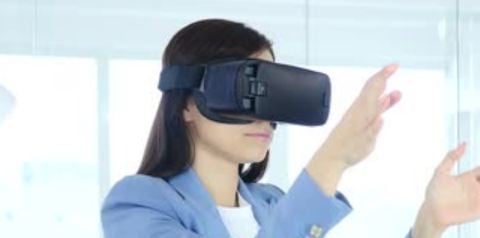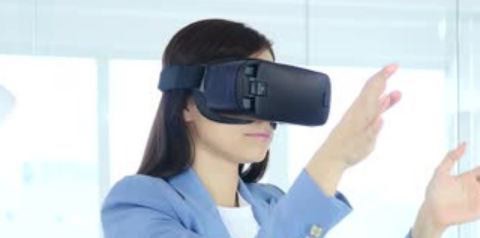Virtual Reality began its exciting takeover of healthcare, bringing both patients and doctors great joy. These are five amazing examples of medical virtual reality that have transformed the lives of patients and changed how doctors work. It is possible to swim in the ocean with whales while still being in a hospital bed.

The area of medical VR has many exciting possibilities. It is not only inspiring science-fiction lovers but also clinicians and real-life doctors. Even though VR is still a relatively new field, there are many great examples of VR having an impact on the lives of patients and doctors’ work. This is why the demand for healthcare app development services is getting higher with time.
Here we have covered all the aspects that show how Virtual Reality is completely transforming the healthcare industry. Let’s get started with the same.
VR And Healthcare: Synopsis
Virtual reality (VR), although often associated with gaming, is a new-generation technology whose potential applications could revolutionize many industries. Healthcare professionals are looking at VR to help patients and providers achieve better outcomes. This includes surgery, pain management, and mental health.
Healthcare professionals are looking at new ways VR can help patients and providers achieve better outcomes and treatments. You just need to Hire healthcare app developers who can understand your business needs and help you with the best outcomes. The following segments show how VR has revolutionized telehealth for patients and professionals around the globe.
Let’s get started.
- Patient Education And Communication: Virtual Reality allows you to travel inside and around your body to view and access areas that are otherwise impossible. This allows clinicians to present vital information to patients in real-time. It also helps them visualize their condition and to see how treatments and therapies will work. Patients can better understand and learn about their condition from home. High-quality medical consultations can also be delivered without the need to travel, saving valuable manpower.
- Transforming Industries: VR is rapidly rising worldwide with a compound annual growth rate. We all stand to gain from VR’s potential for transforming and penetrating many industries. VR app development services have produced many medical applications. Researchers continue to find new ways to use technology to enhance healthcare and provide more effective treatments to patients.
- Relaxing patients: As a patient, have you ever felt like time is slipping away in the hospital? You feel that there is no way out, you don’t know what to do, and are worried about your health. It is understandable that anxiety while in the hospital, constant worry about upcoming procedures, and the pain one can experience during or after a procedure can be stressful. VR offers a way to relax patients and make them feel less stressed.
- MEDICAL TRAINING: Students and teachers have access to interactive digital models that offer a more advanced way to visualize human anatomy than traditional cadaver or book-based lessons. Clinician examinations, such as OSCEs, can be reproduced and taught to match the curriculum. Simulating bespoke surgical procedures is possible with no patient risk. This creates safer environments and increases learning. The virtual model can also respond in dynamic ways to prosected specimens. Students and teachers can experience a seamless transition from the macro (eg A virtual full-body cardiovascular exam) to the micro (CGI lipo molecules that contribute to luminal obstructions). This all contributes to a better understanding of physiology. Visualized Mechanisms of Action can help you understand complex pharmaceutical concepts.
- Mental Health Treatment: VR can be used by patients to treat anxiety and trauma. A psychologist may be able to treat someone who has been traumatized by a car accident by using virtual exposure therapy. This is safer than visiting the patient in person. The results are quite impressive. Research showed that VR therapy reduces the fear of heights by more than 60%. This treatment can also help those suffering from other psychological disorders and phobias such as depression and post-traumatic stress disorder.
- Accelerating recovery: Time is crucial for patients who have survived strokes or brain injuries. Patients who have suffered a stroke or traumatic brain injury will need to start rehabilitation as soon as possible. This increases their chances of regaining their lost functions. Neuro Rehab VR is a gamified method of physical therapy that aims to help such patients. The company works with doctors and therapists to develop VR practices that use machine learning to adapt each exercise to the patient’s therapeutic needs. Its goal is to make physical therapy more fun and increase patient engagement.
- Adjunctive Therapy: Mental health can be delivered using Unity-based virtual worlds and 360 videos. Empathy is one of the greatest strengths of virtual immersion. AbbVie, a pharmaceutical research and development company, created an experience to increase awareness among healthcare professionals about the daily struggles of Parkinson’s patients. At an industry trade fair, the experience was demonstrated. Participants could wear a headset to experience firsthand how a Parkinson’s patient navigates a virtual grocery store and encounters awkward moments with other people.
- Enhancing Memory and Cognitive Functions: Seniors can use VR technology to improve their cognitive function and memory, as well as rehabilitation therapy and socialization. Research has shown that VR interventions can improve cognitive function and motor function in older people with mild cognitive impairment. Research has shown that VR can enhance cognitive rehabilitation efforts for MS and stroke patients. It increases sensory input and promotes multisensory integration.
- Pain Management: VR’s healing abilities are not limited to psychological problems. Researchers from the UW Harborview Burn Center and the University of Washington Seattle found that VR immersion reduced pain for patients undergoing physical therapy following a skin transplant. The effectiveness of VR in physical therapy has been proven to speed up the recovery process. The patient can do their daily exercises in a virtual setting, which makes it more enjoyable and keeps them focused. This helps them to keep their spirits up during a lengthy recovery period. Virtual reality even allows stroke rehabilitation.
- Physical Therapy Enhancements: VR has been proven to be a useful tool for patients who need physical rehabilitation. Motion-enabled gaming and VR programs can be used to recreate exact movements and motivate patients for exercise. To adapt programs to patients, therapists can adjust all settings. VR rehab allows patients to practice real-life skills like dishwashing and grocery shopping. VR can be used to improve motor function in children with cerebral palsy.
- Improved Surgical Efficiency: George Washington University has developed a VR tool that allows surgeons to virtually examine a patient’s body and brain before they perform a procedure. This allows surgeons to be more efficient and aware of the situation. Patients and their families can also gain a better understanding of the procedures in advance. The Harvard Business Review found that VR training increased surgical performance by 230% in comparison to traditional methods.
The Future
AR and VR are more than exciting new technologies. They have been shown to be beneficial in extensive learning across all the verticals of healthcare.
Immersive technologies such as Augmented Surgery will become more popular in the future to increase the effectiveness and accuracy of existing procedures. The ability to care for patients and their caregivers will be improved. There will also be greater access to vital information and skills that can save lives.
Only creativity and ingenuity in mobile app development services can limit the potential of VR in healthcare. Virtual reality tools can bridge the gap, not increase them. In the end, virtual reality will make us all more human.
Get in touch with the dedicated team of mobile app developers to learn more about how Virtual Reality Healthcare can help you achieve your business goals. Having the right mobile app development company by your side can certainly assist you to move ahead and make the most out of it.
Author Bio
Scarlett works with the editorial team of A3logics, a leading company offering IT consulting services. Exploring the latest technologies, reading about them, and writing her views have always been her passion. She seeks new opportunities to express her opinions, explore technological advancements, and document the details. You can always find her enjoying books or articles about varied topics or jotting down her ideas in a notebook.
Interesting Related Article: “What is virtual reality or VR? definitions and examples”













